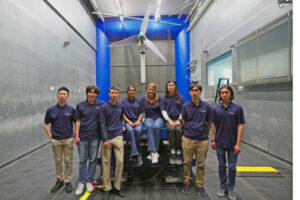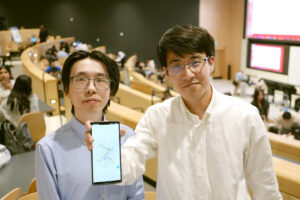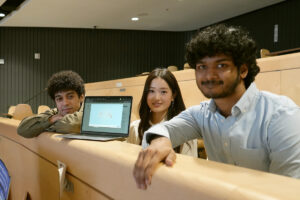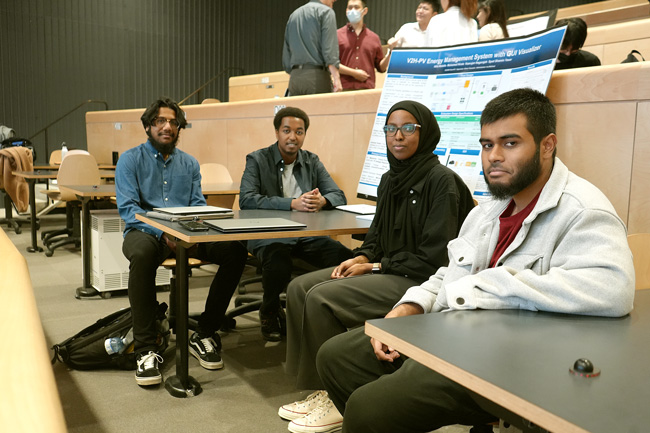
MAY 8, 2023 • By Matthew Tierney
Last month, the Myhal Centre main auditorium was for the second consecutive year the scene of the ECE Capstone Design Fair, and the talent and ambition of ECE undergrads did not disappoint.
Professor Bruno Korst coordinated the course this year, as part of a rotation of duties with Professor Khoman Phang and Professor Hamid Timorabadi. Korst says the yearlong project design course for fourth-year students, ECE496, is a vital step in their education.
“The teams must draw on their schooling to date and put it all together, from concept to design with an eye towards implementation — and really take on the mantle of engineer,” he says. “This project is for many of them the best design story they can tell in a future job interview. It is something they can talk about with confidence, and it shows that they did not shy away from a challenge.”
“The Capstone project is always a bellwether of how we’re doing as educators because it allows our students to consolidate their engineering knowledge to create something new,” says ECE Chair Professor Deepa Kundur. “Have we given our students the tools and skills to succeed in a competitive industry? Absolutely. The project design showcase was a proud moment for the department. I see a bright future for our soon-to-be graduates.”
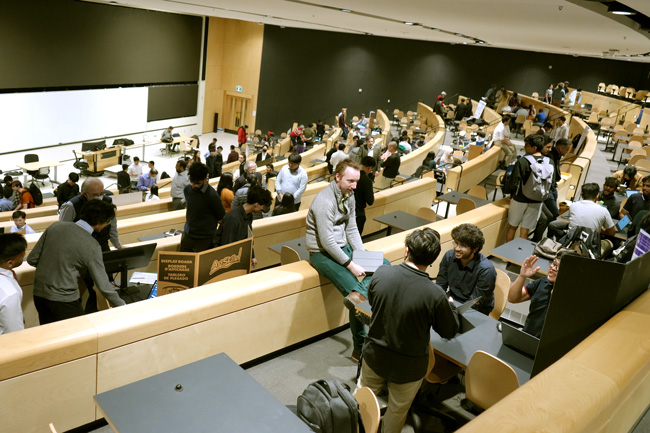
The team of Idilo Abdalla (Year 4 ElecE), Mohamed Hirole (Year 4 CompE), Kaarujan Nagarajah (Year 4 ElecE) and Shamin Yaser (Year 4 CompE) worked out of the University of Toronto Electric Vehicle (UTEV) lab to develop a green design for U of T Engineering’s survey camp in Gull Lake, northern Ontario, currently under renovation.
“We saw an opportunity to show how to power the site with bidirectional charging from an electric vehicle EV),” says Hirole. “You’d drive up the EV into camp and plug it in. The EV would dump any excess battery power back into the grid, which can be used to power the camp.”
The site includes camp bunkies with water heaters, multiple light fixtures and other electrical loads. Throughout the years, civil and mineral engineering students have travelled to the survey camp to practice surveying and field testing, along with other skills of the discipline.
The team envisioned a remote energy distribution system hosted in the cloud, where credentialed administrators could monitor the charge sessions of different EVs through an interface that displays the various power metrics, such as voltage, current, state of charge and other measurements.
A second goal was to “be as independent from the grid as possible,” says Abdalla.
“This means installing solar panels on the roofs of the camp bunkies. These, along with the main battery system at the site, would store excess energy. An energy management algorithm would control the energy flow depending on the load demand."
The team simulated the full distributed environment in MATLAB and Simulink, a programming platform used by engineers to model system designs, and they developed an intuitive graphical interface to demonstrate the feasibility of their plan.
“Simulations don’t necessarily capture everything that could occur in reality,” says Nagarajah. “The next step would have been implementing hardware-in-the loop, which gives you a more realistic view of how the system actually behaves in a scenario.”
The biggest project challenge lay in the integration of all the components, and with the benefit of hindsight, the team believes it would have saved some stress by anticipating this.
“We should have focused more on seeing how we were going to integrate everything along the way instead of waiting until the end,” says Yaser. “This is the kind of system where, if there’s any one point of failure, the whole thing doesn’t work very well.”
The team is confident in their proof of concept and could see others taking this project to implementation.

Nurin Fazil (Year 4 ElecE) and Aryaman Kamath, Abrar Maheer and Harris Zheng (all Year 4 CompE) are the team behind Edeno, an app that identifies and diagnoses the health of your plant, then makes recommendations on how to care for it.
“We learned that plants were gaining popularity after COVID and after lockdowns. Plants actually relieve a lot of stress. They were like the new pets,” says Kamath.
“When we looked at the type of plant care apps that currently exist,” says Fazil, “they had finicky interfaces with features hidden deep in menu, sensors that did not integrate properly, low accuracy readings. We saw a gap in the market.”
Edeno’s smart plant monitoring system uses sensors placed in the soil to gather data for live, direct readings of a number of metrics: pH level, nutrient ratio, soil moisture, air humidity, temperature and light intensity. All have bearing on the health of the plant.
The plant metrics are tracked over time with robust readings — for example, specific measurements for nitrogen, phosphorus and potassium, the three main plant nutrients — as well as scientific recommendations tied to the species. To add a bit of motivational fun, users were given a score based on how well they are caring for their plant, which could be compared with other users.
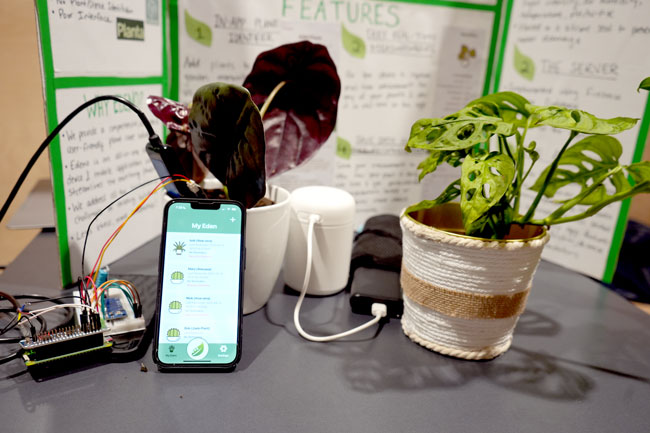
Considering that their target user could have little experience with plants, the team built in a feature that draws on an API database to identify an unknown species based on a snapshot. Additionally, says Maheer, it can identify fungi or other substances that cause disease.
“Say your plant is dying or doesn’t look right. Maybe it has some weird stuff on it. You take a picture of the plant and the app will tell you what’s wrong with it. You use that information to decide the best way to bring it back to life.”
The team put a lot of research into learning which sensors gave the most accurate values, and calibrating their different interfaces into one package was a challenge. The chip shortages did not make procuring the sensors any easier.
“If we could bring the costs of the sensors down, there definitely could be a market for this,” says Zheng.
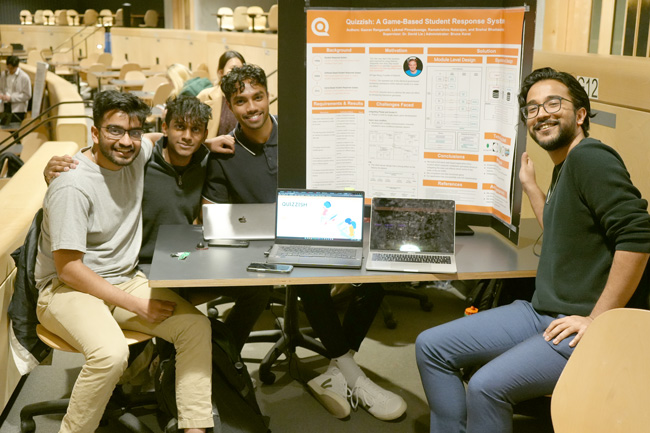
The four members of Quizzish — Ramakrishna Natarajan, Lakmal Pinnaduwage, Snehal Bhattacharya and Gaurav Ranganath (all Year 4 CompE) — developed a multiplayer, game-based response system aimed at high school students.
Such systems have found traction in the last decade, says the team — though their research revealed that Alf Inge Wang, the founder of today’s popular Kahoot! system, admits there is a ‘wear-out effect,’ where frequent use in an identical game environment lowers student motivation.
“That’s where Quizzish comes in,” says Natarajan. “We wanted to fight the wear-out effect by adding interactive multiplayer game play to the mix, trying to increase the levels of engagement.”
The retro-vibed spaceship game that the team built uses a simple math question to demonstrate game play. Students join the communal game environment on their own device and are given control of a ship. There are possible answers displayed in mulitple hangars at the top of the screen, and students must pilot their ship to the correct one.
Students can see what their peers are doing — that is, those who are unsure of the answer can follow where other ships are headed — though the teacher has the option of randomizing the hangar answers on each student’s screen to negate this strategy.
“It’s not just me trying to answer the question. It’s all these other players trying to get the right answer too,” says Pinnaduwage. “All the ships converge. It’s not exactly a competition but there’s a visual cue that can help reinforce the learning.”
Up to ten players can play at a time, and a leaderboard tracks the game progress.
“This gives the teacher qualitative information on how much the students understand and what the students’ scores are across the board,” says Pinnaduwage.
The teacher can create modules for English, math, biology or any other subject, and turn team-based play on or off. The potential is there to develop other game modes beyond the spaceship one, says the team.
Developing the full-stack web-based application came with its share of challenges, particularly with the component that handled the game-play communication.
“We had to integrate two software programs to generate the multiplayer aspect,” says Bhattacharya, “which opened a can of worms when it came to managing asynchronous issues and keeping the same players in the same forms and questions.”
Then there was the lag in live game mode caused by theclient server architecture. In their original formulation, the team had the client ping the server for a response for every single movement of the ships.
“The solution was to start batching these responses. The overall flow of the game saw a huge improvement,” says Ranganath.
